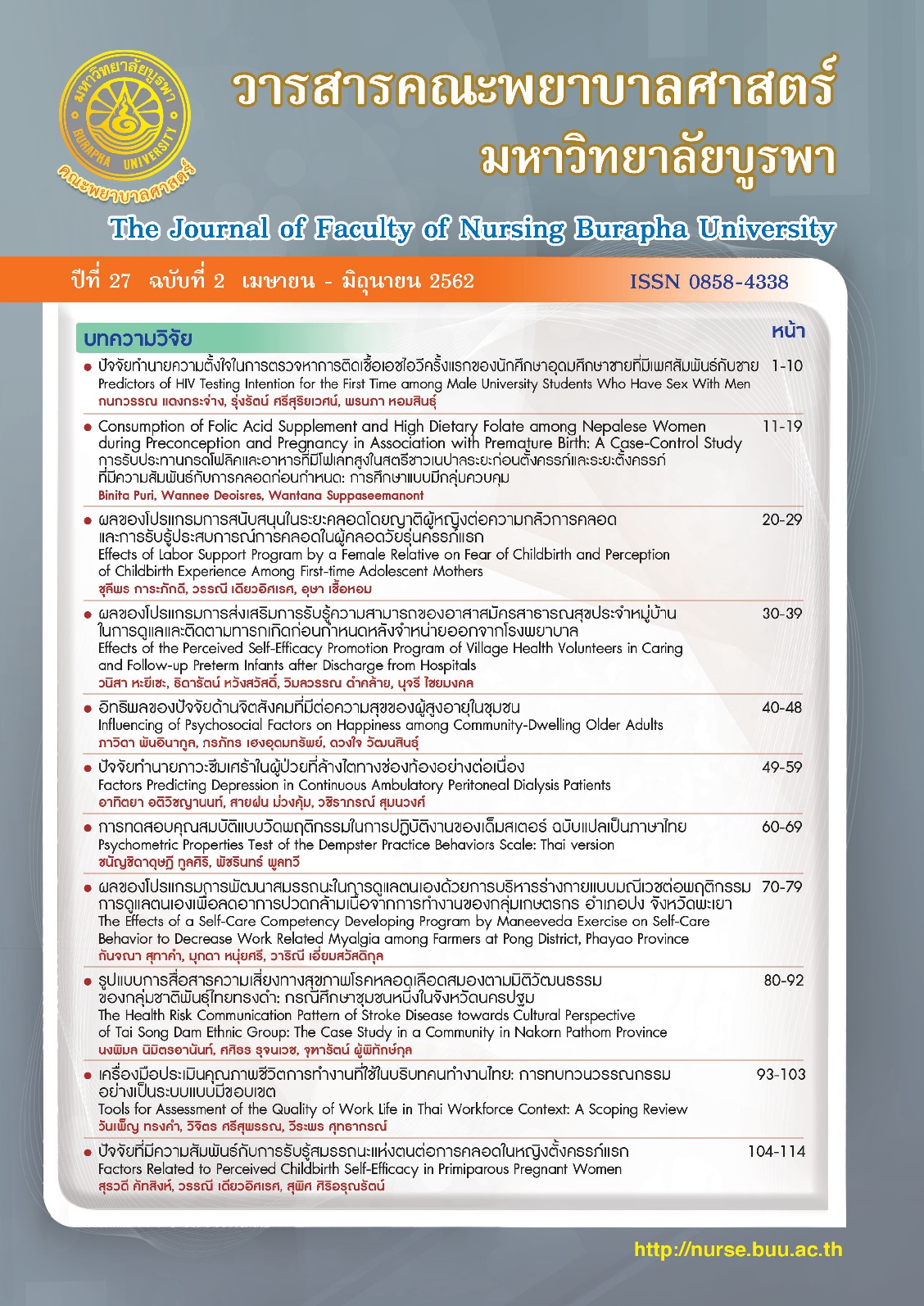ผลของโปรแกรมการสนับสนุนในระยะคลอดโดยญาติผู้หญิงต่อความกลัวการคลอดและการรับรู้ประสบการณ์การคลอดในผู้คลอดวัยรุ่นครรภ์แรก
คำสำคัญ:
โปรแกรมการสนับสนุนในระยะคลอด, ผู้คลอดวัยรุ่นครรภ์แรก, ความกลัวการคลอด, การรับรู้ประสบการณ์การคลอดบทคัดย่อ
บทคัดย่อ
การวิจัยกึ่งทดลองนี้มีวัตถุประสงค์เพื่อศึกษาผลของโปรแกรมการสนับสนุนในระยะคลอดโดยญาติผู้หญิงต่อความกลัวการคลอดและการรับรู้ประสบการณ์การคลอดของผู้คลอดวัยรุ่นครรภ์แรก กลุ่มตัวอย่างเป็นผู้คลอดวัยรุ่นครรภ์แรกที่มาฝากครรภ์และคลอดที่โรงพยาบาลสวรรค์ประชารักษ์ จังหวัดนครสวรรค์ระหว่างเดือนกุมภาพันธ์–พฤษภาคม 2561 จำนวน 47 คน แบ่งเป็นกลุ่มควบคุมจำนวน 22 คน กลุ่มทดลองจำนวน 25 คน โดยคัดเลือกแบบเจาะจงตามเกณฑ์คัดเข้า กลุ่มทดลองได้รับโปรแกรมการสนับสนุนในระยะคลอดโดยญาติผู้หญิง กลุ่มควบคุมได้รับการดูแลตามปกติ รวบรวมข้อมูลโดยใช้แบบสอบถามข้อมูลส่วนบุคคล แบบสอบถามความกลัวการคลอด และแบบประเมินการรับรู้ประสบการณ์การคลอด วิเคราะห์ข้อมูลโดยใช้สถิติพรรณนา และการทดสอบทีแบบอิสระ
ผลการวิจัยพบว่า ผู้คลอดวัยรุ่นครรภ์แรกในกลุ่มทดลองส่วนใหญ่เลือกมารดาตนเองเป็นผู้ให้การสนับสนุนในระยะคลอดมีความกลัวการคลอดต่ำกว่ากลุ่มควบคุมทั้งในระยะปากมดลูกเร็วและภาพรวมการคลอดทั้งหมดอย่างมีนัยสำคัญทางสถิติ (t45 = 3.605, p< .01 และ t45 = 5.946, p< .001 ตามลำดับ) และมีการรับรู้ประสบการณ์การคลอดดีกว่ากลุ่มควบคุมอย่างมีนัยสำคัญทางสถิติ (t45 = -3.855, p<.001) จากผลการวิจัยเสนอแนะว่า พยาบาลห้องคลอดควรจัดให้ญาติผู้หญิงเข้าให้การสนับสนุนดูแลผู้คลอดในระยะคลอดโดยเฉพาะกลุ่มที่เป็นผู้คลอดวัยรุ่นครรภ์แรก เพื่อช่วยลดความกลัวและส่งเสริมการรับรู้ประสบการณ์การคลอดที่ดีแก่ผู้คลอด
เอกสารอ้างอิง
Adams, S. S., Eberhard –Gran, M., & Eskild A. (2012). Fear of childbirth and duration of labour: A study of 2206 women with intended vaginal delivery. British Journal of Obstetrics and Gynaecology, 119, 1238-1246.
Alehagen, S., Wijma, K., & Wijma, B. (2001). Fear during labor. Acta Obstetricia & Gynecologica Scandinavica, 80, 315-320
Anusornteerakul, S., & Kittiprisada, P. (2013). The effect of health education program and relative assistant on pain, fear, anxiety in primiparous during the first stage of labor. Journal of Nursing Science & Health, 36(1), 23-31. [In Thai]
Bryanton, J., Gagnon, A. J., Johnston, C., & Hatem, M. (2008). Predictors of women’s perceptions of the childbirth experience. Journal of Obstetric Gynecologic & Neonatal Nursing, 37(1), 24-34. DOI: 10.1111/J.1552-6909.2007.00203.x
Campbell, D. A., Lake, M. F., Falk, M., & Backstrand, J. R. (2006). A randomized control trial continuous support in labor by a lay doula. Journal of Obstetric Gynecologic & Neonatal Nursing, 35(4), 456-464.
Dick-Read, G. (1984). Childbirth without fear. 5th ed USA: Harper & Row.
Haines, H. M., Rubbertsson, C., Pallant, J. F., & Hildingsson, I. (2012). The influence of childbirth on mode and experience of birth: Retrieved from http://www.biomedicentral.com/147-2393/12/55
Hodnett, E. D., Gates, S., Hofmeyr, G. J., Sakala, C. (2012). Continuous support for women during childbirth. The Cochrane Database of systematic reviews 2012. DOI:10.1002/14651858.CD003766.pub4
Khresheh, R. (2010). Support in the first stage of labour from a female relative: the first step in improving the quality of maternity services. Midwifery, 26, 21-24.
Lowdermilk, D. L., & Perry, S. E. (2006). Maternity nursing (7th ed.). St. Louis: Mosby.
Panyoi, P., Phumdoung, S., & Thiptamphong, B. (2015). Fear of childbirth and coping
strategies of adolescent pregnant women . Journal of Nursing Science and Health, 38(4), 34-43. [In Thai]
Polit, D. F., & Beck, C. T. (2008). Nursing research generating and assessing evidence for nursing practice (8th ed.). Philadelphia: Wolters Kluwer Health/Lippincott Williams & Wilkins.
Saisto, T., Ylikorkala, O., & Halmesmaki, E. (1999). Factor associated with fear of delivery in
second pregnancies. Obstetrics & Gynecology. 94(5), 679-682.
Sansiriphun, N. (2013). Fear of childbirth. Nursing Journal, 40, 103-112. [In Thai]
Serisathien, Y. (1987). Alternative: Relationship between perception of childbirth experience, self-concept, and maternal-newborn attachment in high risk mothers. Master thesis (Master of Science), Mahidol University Bangkok. [In Thai]
Saul, D. J. (2010). Promoting a positive childbirth experience for adolescents. Journal of Obstetric Gynecologic & Neonatal Nursing, 39(6), 703-712.
Soontornlimsili, B., Phumonsakul, S., & Chareonpol, O. (2009). The effect of nursing during labor on laboring stress and perception of childbirth experience of first-time teenage mothers. Ramathibodi Nursing Journal, 15(3), 361-372. [In Thai].
Sukrat, B., & Eamkhong, P. (2017). Statistics on adolescent birth, Thailand 2017. Department of reproductive health, Ministry of Public Health, Bangkok, The Agriculture cooperative federation of Thailand.
Strategic and Planning Division. (2018). KPIs Template 2561. Office of the permanent secretary, Ministry of Public Health.
Subprasert, Y. (1998). Effect of nursing care using non-pharmacological technique of pain relief on pain coping behaviors during delivery, duration of labor and perception of childbirth experience in primiparous. Master thesis (Nursing education), Chulalongkorn University Bangkok. [In Thai]
Toohil, J., Fenwick, J., Gamble, J., D. K., Buist, A., Turkstra, E., & Elsa-Lena R. (2014). A randomized control trial of a psycho-education intervention by midwives in reducing childbirth fear in pregnant women. Birth, 41(4), 384-394.
WHO Health Organization. (2014). Adolescent pregnancy. Retrieved from http://www.who.int/reproductivehealth/ publication/ publist.htm.
WHO Health Organization. (2016). Companion of choice during labour and childbirth for improved quality of care. Retrieved from www.who.int/reproductivehealth/ publication/ publist.htm.
Wijma, K., Wijma, B., & Zar, M. (1998). Psychometric aspect of W-DEQ: A new questionnaire for the measurement of fear of childbirth. Journal of Psychosomatic Obstetrics and Gynecology, 19(2), 84-97.
Yuenyong, S., & Rakthai, N. (2011). The effect of labor support by close relative on pain, anxiety and satisfaction with childbirth experience among primiparous mothers. The Journal of Faculty of Nursing, Burapha University, 19(2), 67- 82. [In Thai]





